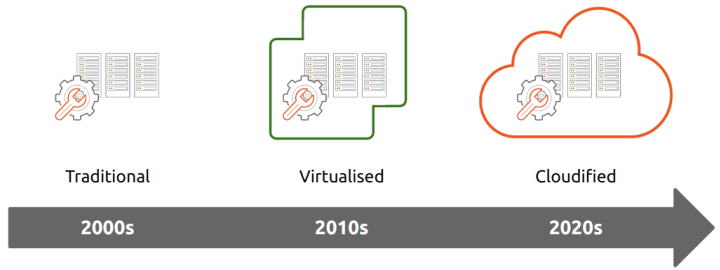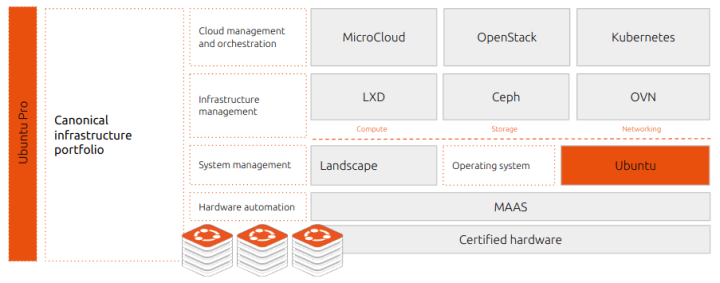Cloudify your data centre – A guide to VMware infrastructure transformation
Tytus Kurek
on 20 May 2024
Tags: cloud infrastructure , Data centre , microcloud , OpenStack , Private cloud , VMware
You know what’s going on. You’ve been monitoring the situation around VMware for at least a year now. There is no need to convince you that whatever comes next, you have to prepare for a big change. You and your team are already well prepared. You have a budget, timeline and necessary resources. However, one thing that you’re missing is the answer to the “HOW?”.
If this is the case, you are in the right place.
Join our webinar on 11 June at 4:30 PM CET and learn how to move from VMware to the future.
If you don’t have time for this 60-minute webinar, he’s a condensed summary for you to read instead. In this short blog we present Canonical’s proven path to VMware infrastructure transformation which comes through a process of full data centre cloudification. We also discuss why it’s better to move to the future rather than stay in the past.
Past vs future
The last two decades have brought a significant change in how enterprises run their IT estates. Many organisations that used to operate their data centres in a traditional way decided to fully virtualise their workloads for better resource consumption and improved agility. This is where VMware came in with its comprehensive vSphere suite. By providing an enterprise-grade platform and answering its customers’ needs, VMware quickly established itself as a dominant player in the virtualisation market.

Unstoppable technological continuum
However, 20 years after this spectacular early success, VMware customers face a dilemma in what to do next. In search of a reasonable alternative they often choose other proprietary virtualisation solutions – but even though solutions like that often look like low-hanging fruit, they might lead to exactly the same challenges in the future as those organisations are facing now. Those include vendor lock-in and a total cost of ownership (TCO) increase. This is why staying in the past – on VMware or not – is sub-optimal, in general.
There is no doubt that the cloud computing paradigm is the next big thing that comes after this initial virtualisation wave. According to Gartner, overall spending on cloud infrastructure will approach 50% of organisations’ IT budgets by 2025. However, using public clouds only might lead to the exact same challenges you’re facing right now. Fortunately, there are ways to build a fully functional cloud infrastructure on your premises.
Cloudify your data centre
You’ve likely heard about OpenStack, the world’s leading open source cloud platform. In fact, you should also consider some other alternatives. Take a look at Canonical MicroCloud, for example. Whichever alternative they’re considering when migrating out of VMware, organisations usually expect the cloud to behave exactly as the vSphere suite.
This is a trap!
The cloud is a cloud with all its pros and cons. No matter which cloud environment you’re in, its underlying architecture and operational principles are slightly different from VMware’s technology stack. This stems from the fact that the cloud computing paradigm was invented to solve slightly different challenges than pure virtualisation.
So what? Does it mean the cloud cannot supersede VMware?
Not at all! It only means that the migration is going to be an exciting journey. While the vast majority of VMware’s features have an equivalent in the open source space, in some cases changes to workload architecture might be required as well. How significant are those changes and is it really worth the overall investment? Continue reading to learn how to make your workload cloud-ready.
Cloudify your workload
We all know what is cloud-native, but how about cloud-ready? Let’s take a step back. Cloud-native is definitely where you should aim to be in the long term; However, for the initial wave of migration, being cloud-ready is sufficient.
The challenge is that some of VMware workloads are so-called legacy “pets”. Those are workloads which were visualised in the past and have never been re-designed since then. They usually rely on some VMware native features, such as vSphere HA or Fault Tolerance. Expecting such workloads to behave exactly in the same way when running on the cloud proves to be a little bit challenging. It is not impossible, though.

Canonical infrastructure stack
Ideally, the workload should be cloud-ready before you attempt to migrate it to the cloud. This means it should preferably meet the following criteria:
- Provisioned and terminated on-demand
- Launched from an image and customised during provisioning
- Designed to store its state on a nonvolatile storage
- Designed to scale out rather than scale up
- HA mechanisms implemented in software or based on native cloud features
- DR mechanisms based on native cloud features or third-party tools
- Designed to use other native cloud features, such as LBaaS, etc.
The most effective and proven way is a gradual, iterative migration. Build the cloud first and move your workloads there starting with quick wins. Many customers actually run both environments in parallel during this initial period. For example Sicredi:
Learn how Sicredi embraces the cloud with Canonical OpenStack >
To sum up, the migration to the cloud is a non-trivial task and it doesn’t happen overnight. However, if properly planned and executed, it brings tangible benefits, uplifting organisations far into the future.
Learn more about cloudification
If you found this topic interesting, we’d like to encourage you to explore it in more detail.
Join our webinar on 11 June at 4:30 PM CET and learn how to move from VMware to the future.
In this webinar we will discuss the future of an on-prem infrastructure and show how the cloudification process looks like under the hood. We will also demonstrate how to effectively migrate from VMware and present some success stories with our reference customers.
Microcloud. Same great performance.
Deploy highly available, secure, and dense microcloud environments anywhere, with a lightweight cloud infrastructure that’s designed for the edge.
Newsletter signup
Related posts
OpenStack cloud – happy 15th anniversary!
Happy birthday, OpenStack! It’s astonishing how fast time flies – fifteen years already. Yet, here we are: OpenStack cloud still stands as a de facto standard...
OpenStack PoC? No problem!
Setting up a proof of concept (PoC) environment is often one of the first steps in any IT project. It helps organizations to get to grips with the technology,...
OpenStack with Sunbeam for medium-scale cloud infrastructure
The rapid growth in OpenStack installation and orchestration tools that we have seen in recent years has effectively established OpenStack as the world’s...
